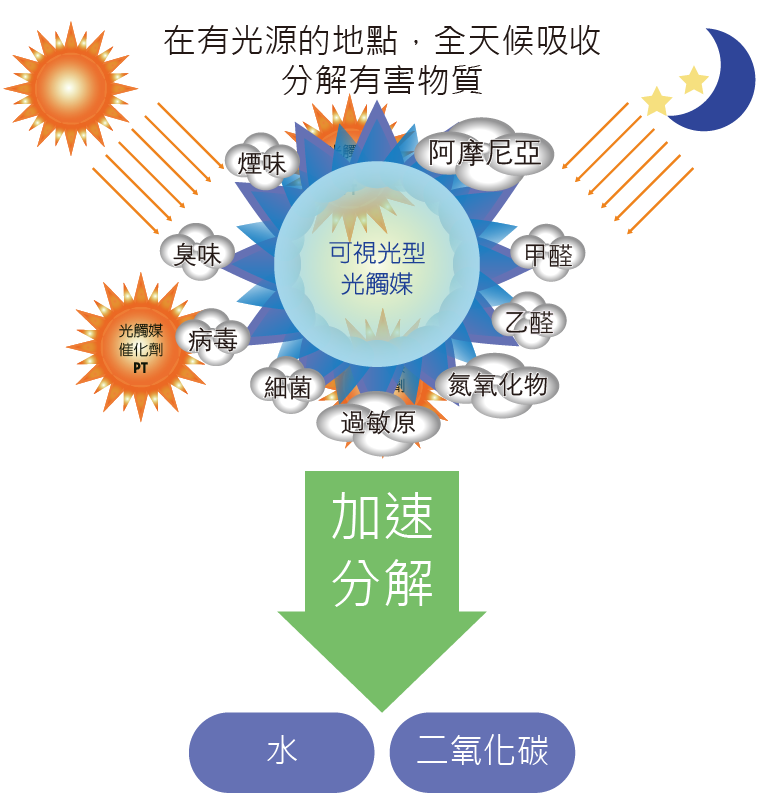In our daily life and work environment, there are countless bacteria, viruses and carcinogens, which affect health. If you want a healthy life, naturally you need to learn about various sterilization and deodorization technologies to make the best choice for yourself and your family!
What is Photo-catalyst?
Photo-catalyst is a generic term for photo-semiconductor materials with photo-catalytic function represented by nano-sized titanium dioxide. It is coated on the surface of substrates and produces a strong catalytic degradation function under the action of ultraviolet light: it can effectively degrade toxic and harmful in the air Gas; can effectively kill a variety of bacteria, and can decompose and harmless toxins released by bacteria or fungi; at the same time, it also has functions such as removing formaldehyde, deodorizing, anti-fouling, and purifying air.

In the field of removing formaldehyde, titanium dioxide (TiO2) is being used. Simply put, the titanium dioxide filter in the air freshener will absorb the formaldehyde passing through and use the light to produce a catalytic effect, thereby converting formaldehyde into carbon dioxide or water. In addition to formaldehyde, photo-catalysts also have bactericidal and virus-killing capabilities, but sufficient light is a necessary condition for photo-catalyst sprays and cleaners to break down toxins
What is a water catalyst?
Unlike photo-catalysts, water catalysts are a new technology developed by Japanese expert Dr. Daiki Miyamoto and patented worldwide. They can also be understood as "inorganic metal catalysts" and are not affected by changes in external environmental conditions such as light (ultraviolet rays). The performance of the mechanism depends on the "atomic group (-OH, etc.)" produced by water molecules in the air, and produces a mechanism reaction. Water catalysts can decompose formaldehyde, VOCs in the air, and have superior performance in antibacterial and anti-fungal functions, and can establish a continuous antibacterial protective cover for different environments.

The water catalyst is made of alumina, silicon oxide, titanium, phosphorus and other materials, and is a "composite metal compound" polymerized by high technology. Its material composition has electronic properties. When applied, the solution will form a nano-scale grid-like film layer with semiconductor properties, capturing and locking the volatile organic compounds (formaldehyde, acetaldehyde, benzene, toluene, xylene) released from the object and released to the film layer in the air , Etc. VOCs), decompose and convert them into H2O and CO2, and simultaneously decompose corresponding pollutants such as microorganisms.
Decomposition principle
Water catalysts can use oxide molecules (titanium oxide, silicon oxide) that have been dissolved in water to form a conductive film on the surface of the material. When this conductive film is in contact with water in the air, it will generate oxidative free radicals (unpaired electrons). It is called a hydroxyl group (chemical formula is -OH). This free group (unpaired electrons) can take away the electrons of VOCs, so that the separated C (carbon), H (hydrogen), and O (oxygen) are converted into H2O (water). And CO2 (carbon dioxide) and other harmless substances.
Four characteristics
* Maintain air quality in confined spaces
* Antibacterial, deodorant, moisture-proof, formaldehyde removal
* Japan Food Analysis Center Safe Food Test, SGS Skin Sensitivity Test
* 5,000 rubbing tests on sandpaper in Japan, lasting effect and continuous decomposition for 24 hours

Due to its excellent stability, the water catalyst not only covers and penetrates evenly on the surface of objects, exerts its performance in a large area, but also is not easy to fall off and remove. Its "hydro-philicity" and "self-cleaning", and grid The structure of the film-like layer is such that the material of the film layer is not covered by dust and dirt.
According to international standards, water catalysts are non-hazardous chemicals, ensuring safety and non-toxicity. When used, they can contact human skin without causing damage, and will not cause damage to objects, such as corrosion and color changes, or damage to the environment ( Water, soil, etc.) cause pollution.
Water-catalyst VS Photo-catalyst
|
Items |
Water-catalyst |
Photo-catalyst |
|
Tightness |
Adhesion is tight. After special testing in Japan, the metal coating can reach jade hardness, and the abrasive paper has abrasion resistance of 5000 times without abrasion. |
Easy to wear, low wear resistance |
|
Transparency |
Transparent and colorless after drying |
Cloudy, white powder remains after drying |
| Chemical decomposition conditions | Chemical action caused by contact with moisture in the air, continuous decomposition all weather | Chemical action only when sunlight reaches a certain intensity |
|
Application scope |
Outdoor, non-vacuum all environments |
Only suitable for outdoor construction, indoor use must be additionally used with UV light |
| Deodorizing effect | Continuously decomposes offensive odors caused by bacteria and chemical molecules, and has a particularly significant effect on smoke, toilet and Armenian odor |
Can only remove part of the chemical odor, the validity period is relatively short |

In comparison, water catalysts and photo-catalysts can achieve powerful effects such as deodorization, antifouling, antibacterial, anti-mildew, and reduction of harmful gases. However, the strong dependence of water catalysts and the sustainability of regeneration make them more effective and sustainable. Antibacterial effect.
Tested in Japan, the water catalyst is effective against bacteria such as pneumoniae, Pseudomonas aeruginosa, coliform, and bacillus cereus, and can contact human skin without causing harm. As long as it is exposed to the moisture of the air, it can convert harmful molecules such as VOCs into harmless substances such as water and carbon dioxide.
Compared with photo-catalysts, water catalysts have a longer effect because they no need to rely on light to generate decomposition.



